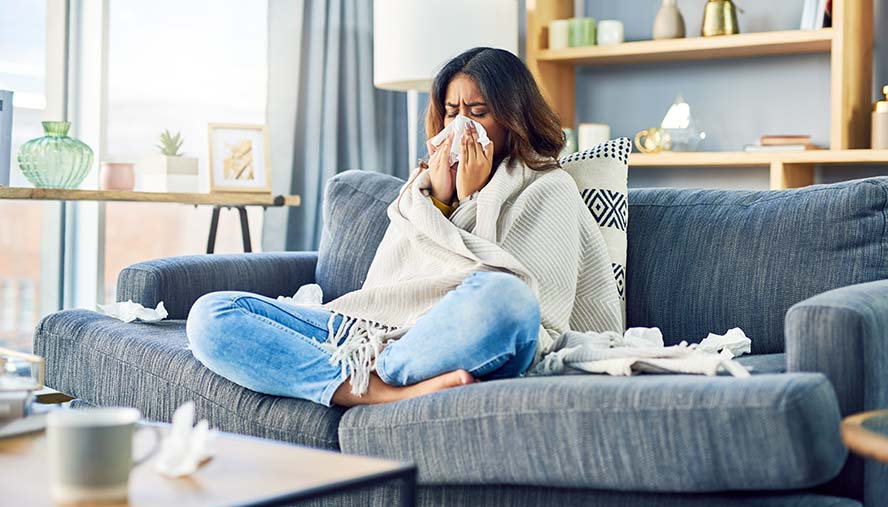With COVID Still a Problem, What Will This Year’s Flu Season Look Like
This information was reviewed and approved by Charles L. Daley, MD, Chief, Division of Mycobacterial & Respiratory Infections (October 2021).
Updated November 30, 2021
One unexpected positive to come from the COVID-19 pandemic was the remarkably light flu season last winter. Can we expect a similarly low level of flu infections this season as the pandemic ends its second year?
Health experts are concerned that won’t be the case this year and that we will see influenza back at a higher level. That’s because as variants continue to evolve, including Delta and Omicron, the world has take a cautious approach to opening up. People aren’t wearing masks, washing their hands or socially distancing quite as diligently as they were last year, all measures that kept them safe from both viruses before COVID vaccines were available.

“I hope people behave like they did last year and go ‘Wow, I don’t want to get anything,’ because you’ll get sent home if you have a fever, no matter what it is,” said Charles Daley, MD, a pulmonologist and chief of the Division of Mycobacterial and Respiratory Infections at National Jewish Health. “But kids are back in school. Many people are back working in offices, some with masks, some without. Any time there is congregation of humans this season, there is going to be flu.”
Fortunately, safe and effective vaccines are available right now to most people for both illnesses.
Below are answers to some questions you might have about the coming flu season.
“In places that are overrun with COVID, they have no resources left to deal with influenza,”
said Dr. Daley.
What should we expect for the coming flu season?
There are a lot of research models in progress that are trying to project this year’s flu season, but it is difficult to know.
Last year was a historic low for flu cases. Not only were people taking extra measures to protect themselves from COVID-19, but also a record number of influenza vaccines (193.8 million doses) were distributed in the United States.
This resulted in a little more than 2,000 confirmed flu cases and about 750 deaths, according to the Centers for Disease Control and Prevention (CDC), down from an average of 39 million cases and 22,000 deaths.
Australia is ahead of the United States’ flu season every year and so far they have had very few cases.
Hopefully, the United States follows suit, as our hospital resources continue to be strained.
Prevent Flu & COVID-19
|
“It’s going to vary regionally, but in places that are overrun with COVID, they have no resources left to deal with influenza,” said Dr. Daley. “That’s why this year, just like last year and more than any other year, it’s very important that we prevent flu.”
When should I get vaccinated for the flu?
That answer may depend on your age group and circumstances, but generally, the CDC recommends September and October as the best months to be vaccinated, ideally before the end of October. It takes about two weeks for the flu vaccine to start protecting, so you want to have that protection working before the holidays.
Can you get both vaccines at the same time?
Yes, if you are eligible, you can receive both the influenza and COVID-19 vaccines at the same visit. In fact, this is recommended by both the CDC and its Advisory Committee on Immunizations Practices. Look for a clinic that will provide both vaccines, to make it very convenient for you.
Standard annual flu vaccines are approved for everyone 6 months and older. Right now, the CDC recommends everyone 12 years and older can get vaccinated for COVID-19. Authorization for kids aged 5-11 years old could happen soon.
Also, though the symptoms are similar, the viruses themselves are different, and so are the vaccines. The flu vaccine is designed to protect against the flu, not COVID-19 and vice versa.
Can you get sick from both influenza and COVID-19 at the same time?
Unfortunately, yes. Though it is rare, you can get both COVID-19 and the flu, and other respiratory illnesses, at the same time. There have not been any studies to prove how the combination of influenza and COVID-19 would impact someone, but we would advise people get both vaccines to be as safe as possible.
The symptoms are similar. How do I know which one I have?
You likely won’t know which virus you have without getting tested. The viruses can present identically, with symptoms that include fever or chills, cough, fatigue or muscle aches. Fortunately, if you feel you need to be tested, most centers have more kits available this year than they did last year.
“Right now, if you show up in an urgent care center or a clinic and you have a fever and a cough, you’re believed to have COVID until proven otherwise,” Dr. Daley said. “So the only way to figure that out is to test.”
Is there one test that can diagnose both the flu and COVID?
Yes, these tests do exist, but not every center carries them. Some commercial tests can determine if someone has any of 20 respiratory viruses, such as RSV, adenovirus, influenza or COVID-19. However, most health care operations will likely just test for either the flu or COVID-19, using nasal swabs or rinses.
Should I get tested for COVID anytime I have flu/COVID symptoms?
That depends on your age and health status. Dr. Daley said those at higher risk for complications, either older or immunocompromised individuals, should get tested to receive the right kind of care.
“This is important because we have treatments for flu and we have treatments for COVID,” Daley said, “So getting tested is important now because that’s going to help your health care provider figure out which therapy you should receive, if you are at higher risk.”
Bottom Line
There is no question the flu is coming. It comes every year and COVID-19 has been with us for almost two years. How much of a problem either will pose is up to us.
“People should get vaccinated now for both the flu and COVID-19,” said Daley. “If we want to decrease the flu epidemic and the COVID pandemic, we have to do that through vaccination.”
| The information on our website is medically reviewed and accurate at the time of publication. Due to the changing nature of the COVID-19 pandemic, information may have since changed. CDC.gov and your state’s health department may offer additional guidance. |


